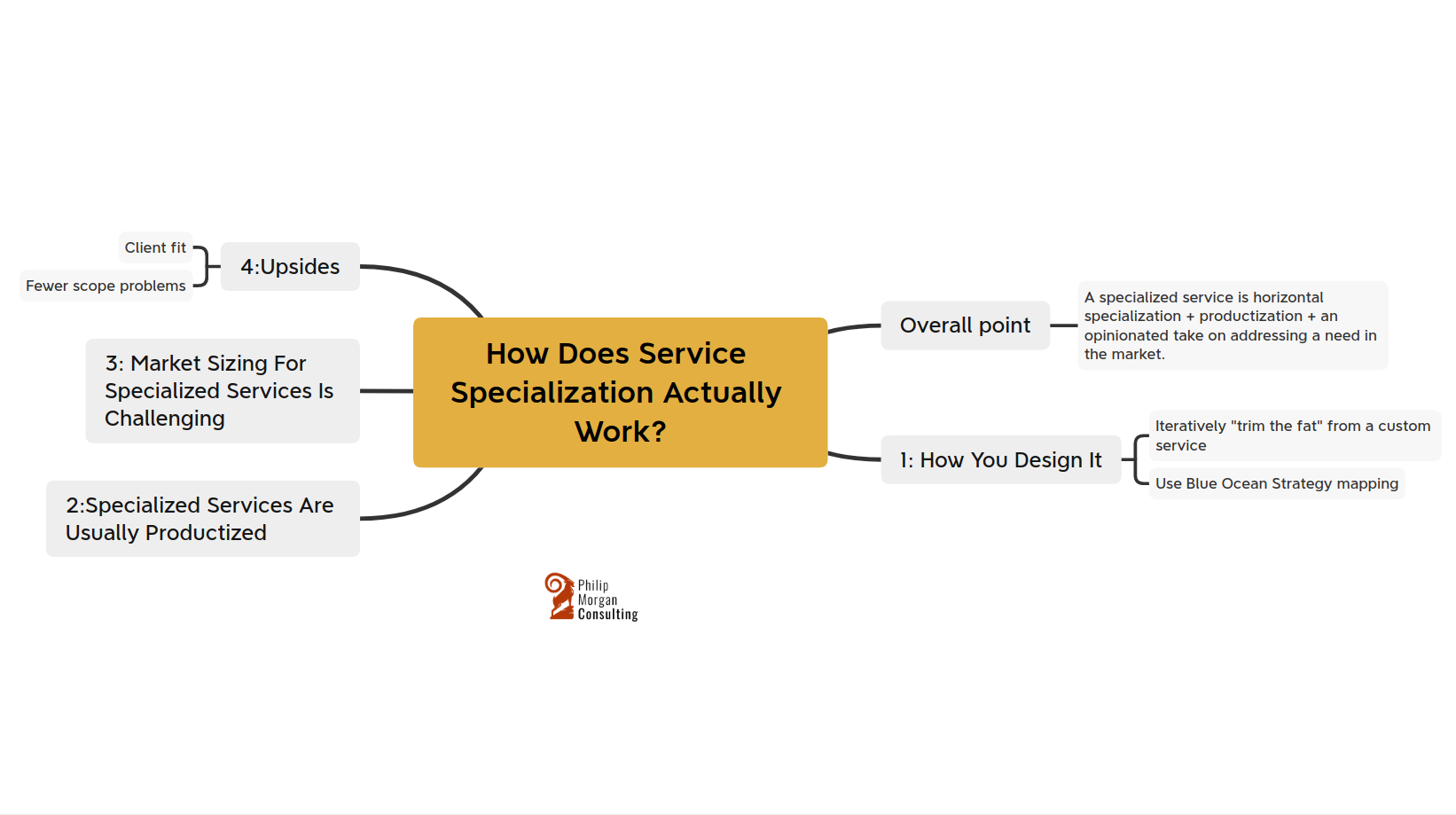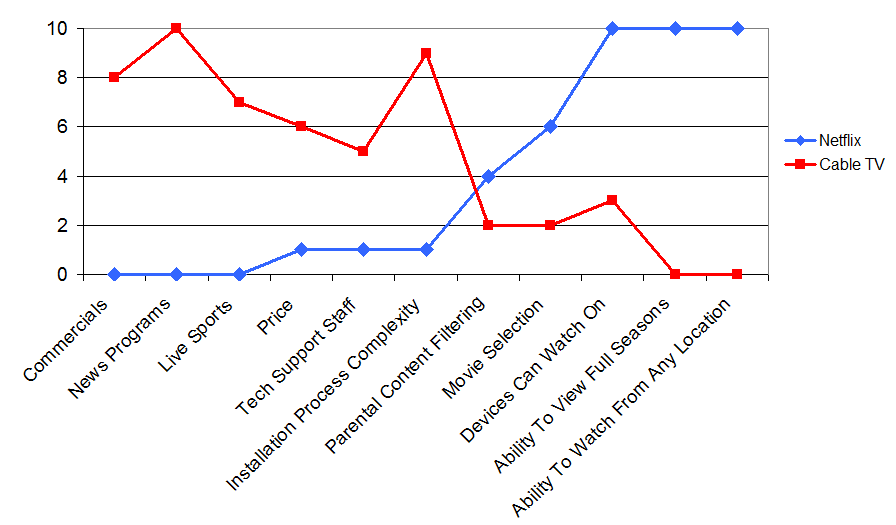How Does Service Specialization Actually Work?
In The Positioning Manual for Indie Consultants, I describe the 5 ways of specializing. A service specialization is one of those 5, and I've gotten at least one request for more detail on how service specialization works.
A service specialization is usually horizontal in nature, but it's differentiated from a pure horizontal specialization by delivering a solution that is very opinionated or productized.
Pure horizontal: "We build great websites"
Service specialization: "We build you a really good website in a day so you can get back to the work that matters"
Adding this opinionated or productized element to a horizontal specialization produces several interesting benefits, including market differentiation, potentially better-fitting clients, and increased profitability.

Designing A Specialized Service
I've interviewed a few folks with specialized services, including Pia Silva of Worsofall Design, who will be our prime example throughout this article. The motivations and process by which these folks design their specialized services differ.
Some of them iterate their way into a specialized service by cutting out the wasteful or unpleasant parts of a custom service offering. Others might start by looking for a hole in the market and designing something to fill it. There's not just one design process used to create a specialized service.
If I were to propose a design process, it would be Blue Ocean strategy mapping. This uses a simple "strategy canvas" to decompose competing services or client needs into discrete components so that you can think more clearly about what your service does and does not offer.
Here's a good example:

Source: https://profitworks.ca/blog/378-blue-ocean-strategy-formulation-the-strategy-canvas
The Blue Ocean strategy canvas clearly visualizes how exactly Netflix differs from cable TV. It also points out the necessity of deciding and following through on the "no's" of strategy -- those decisions about what you will not do.
If you wanted to design a specialized service, you might start by asking, "what does the market hate about X?"
This question leads into a few more:
- What new tools/technology might help address this?
- What do we all assume is required but might actually be optional?
- What would a partial or incomplete solution look like?
All together these questions get you focused on user desires and then thinking creatively about fulfilling those desires in a way that's different from the status quo.
Worstofall Design offers what would be a horizontally specialized service (branding) but does so with a specialized service instead. It has 2 parts:
- A Brandshrink, which is a 2.5-hour interview that yields a creative brief. ($4,950 at time of writing)
- A Brandup, which is a 1 to 4-day build sprint that yields a website and related collateral. ($24,950 to $59,950 at time of writing)
Again, I interviewed Worstofall's co-founder Pia Silva, and I recall her describing a service design process that looked more like iteratively cutting out the wasteful or unpleasant parts of a custom service offering. However, starting with the question "What do the clients we work with hate about branding work?" could have also led to a similar place because some of them hate:
- Open-ended projects that feel neverending and unstructured.
- Not knowing for sure how much the branding work will cost.
- Not know for sure what they will get out of the project.
You'll notice that these are the key points of differentiation (in terms of service delivery) between Worstofall's services and custom branding services.
This "what does the market hate?" approach has limits, of course. If the market hates getting feedback on MVPs, eliminating the feedback entirely probably won't work because it's actually important to get feedback on an MVP. That doesn't mean you should ignore that pain point, but you might have to take on the more challenging task of attacking it differently.
Productized And Opinionated
A specialized service recognizes a desire or aversion in the market and offers an opinionated answer -- a service that is tailored to address that desire/aversion. This necessitates productizing that service; standardizing and defining it so that it's delivered in basically the same way for everyone who buys it.
Productizing, when done well, can increase profitability. I hasten to add that customization, when done well, can also increase profitability. The latter can be a more dramatic, extreme way of increasing profitability. These two paths to greater profitability use opposite approaches, and so you should think about which approach would better suit you, your personality, and your preferences.
1: Does progressively improving a service, progressively learning from customers, keeping a pipeline of opportunity filled, and steadily increasing your price appeal to you?
2: Or does hunting for a "profitability whale" among an ocean of "profitability tunas" appeal to you?
The specialized service, based as it is on the notion of productization, looks more like #1 above.
The Market Sizing Problem: Who Is It For?
When you're thinking about "doing marketing" for something, you could do a lot worse than starting with this 2-part question: "Who is it for and why do they care?"
When we're thinking about a specialized service, it's often unclear who it's for. This is partly because specialized services are usually horizontally focused, and a pure horizontal focus is on a problem domain without much care for who needs that problem-domain help.
But an opinionated specialized service will imply who it's for. Who are Worstofall's services for? Anyone who:
- Needs branding,
- Is averse to the parameters of an open-ended, custom branding project,
- Resonates with Worstofall's "badass brands" message, and
- Sees more than ~$5k of value in a fast+structured brief-creation process and more than ~$20k of value in a rapid-turnaround brand asset-creation process
This is often what's happening with service specialization: you talk a lot about what-it-is and let the who-it's-for be a self-selected group that includes those who find the what-it-is desirable or appealing.
Market sizing becomes one of the primary challenges/risks of designing a good specialized service. How many prospective clients are out there for a service like Worstofall's? It's difficult to measure with high confidence.
How much does a General Electric AC4400CW diesel locomotive weigh?
If you lived in a converted warehouse and slept in a bed that was about 30 feet from an active set of train tracks, as I did for a while, you have a visceral, felt sense for how much a GE AC4400CW diesel locomotive weighs (and sounds). You might not be able to quantify these things, but boy do you feel them!
With the "iterative trimming-the-fat" service design process that Worstofall used, this difficulty of sizing the market opportunity was never a problem. They just felt that it was big enough.
If you were designing a specialized service starting from the other direction -- starting with a clean sheet and the question "what does the market hate about X?" -- you might face more uncertainty about the market size and therefore the potential for success of your specialized service.
You could do worse than estimating with this extremely rough heuristic:
- What is the market size for the horizontal focus that your specialized service is based on?
- Assume that at most 5 to 10% of that horizontal market will find your opinionated take on a solution appealing.
Service Specialization Upsides
While accurately sizing the market for a specialized service is quite difficult (and designing a service the market wants is also challenging), there are multiple upsides to offering an opinionated, specialized service. There's the aforementioned market differentiation and potential for greater profitability. And then there's client fit.
There's just a je ne sais quoi about clients who resonate with your highly opinionated specialized service. They show up with an extra level of enthusiasm about a service that they feel is tailored to their particular preferences and dislikes. They're more likely to just trust the process and relax into your guidance.
These clients bought a product, not an always-open-to-renegotiation ongoing relationship. They don't expect their Jeep Gladiator to transform into a Tesla Model X while they're driving it down the road, and they're less likely to expect your service to do something other than what you promised them when they bought. These specialized services are often short-timeframe services anyway, further limiting the potential for power degradation in the relationship and scope creep.
Final Thoughts On Service Specialization
We are always making tradeoffs. Service specialization is one particular set of tradeoffs that may or may not be a good fit for you. When it works well, it uses productization and an element of opinionated-ness to attract clients who are both enjoyable to work with and profitable (due to your ability to progressively optimize a standardized service over time).
I hope that this article has helped you understand how service specialization actually works. If you’re looking for more context and detail on specialization and positioning, then read my free guide to specialization for indie consultants.